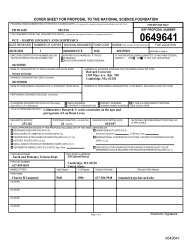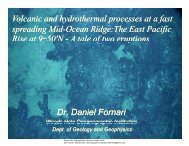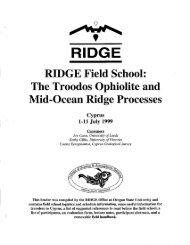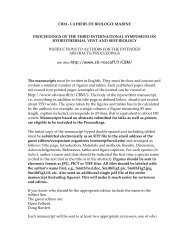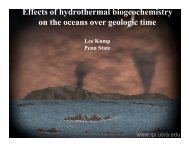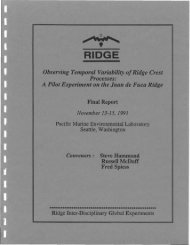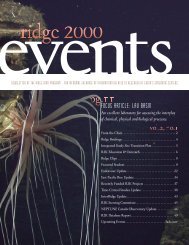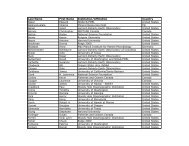You also want an ePaper? Increase the reach of your titles
YUMPU automatically turns print PDFs into web optimized ePapers that Google loves.
o Laboratory experiments must test and generate thermodynamic<br />
and kinetic data for mineral reactions at elevated<br />
temperatures, pressures, and for varying salinity (0.5 to 2<br />
times that of seawater). Near-supercritical conditions should<br />
be emphasized. These experiments must address such issues as<br />
aqueous speciation (inorganic and organic), solid-solution<br />
relations for key alteration phases such as feldspar, chlorite,<br />
and epidote, and fluid-mineral trace element distributions.<br />
Analytical techniques must be developed to obtain more accurate<br />
measurements of trace element and isotopic systematics of<br />
hydrothermal alteration products. Ion and proton microprobe<br />
techniques are expected to be especially useful.<br />
o Numerical techniques and supporting data are required<br />
to permit the modeling in three dimensions of fluid flow in<br />
inhomogeneous ocean crustal rocks. Explicit account must be<br />
made of the temporal and spatial distributions of primary and<br />
secondary permeability (on macro to micro scales) and<br />
pressure-volume-temperature composition properties of fluids.<br />
The effect of different and variable heat transfer mechanisms<br />
must also be included.<br />
o Physical and chemical models of subseafloor hydrothermal<br />
processes must be coupled to include the interconnectedness<br />
of chemical and physical controls on fluid<br />
circulation.<br />
o Techniques must be developed to permit dating of<br />
fluids, igneous materials, and hydrothermal products. These<br />
techniques must make use of absolute and relative dating schemes<br />
and permit timing of events on scales of 1 to 1.000,000 years.<br />
Many of the measurement capabilities required to characterize<br />
seafloor hydrothermal systems need to be improved and<br />
refined.<br />
o Precise and routine positioning on the seafloor is<br />
essential for establishing spatial and temporal relationships.<br />
o Instruments for geophysical measurements and experiments,<br />
including seismic, controlled source electromagnetic,<br />
and passive acoustic, need to be optimized for characterizing<br />
the relevant spatial scales. The high data rates involved<br />
require rapid incorporation of evolving technologies for<br />
instrument control and data storage. Accurate and innovative<br />
permeability measurements in crustal rocks and sediments are<br />
also essential. Remotely operated vehicles (ROV's) should<br />
be developed into powerful tools for mapping, sampling, and<br />
experimental servicing.<br />
o Improved water sampling equipment is needed for use at<br />
high temperature vents and in boreholes. These need to be<br />
42




